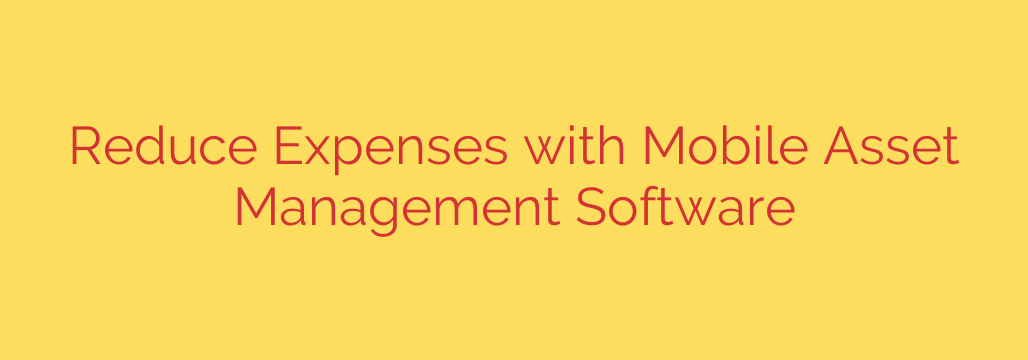
Cut Costs and Boost Efficiency: How Mobile Asset Management Software Saves You Money
In today’s competitive business landscape, every dollar counts. Companies are constantly searching for ways to trim operational costs without sacrificing quality or productivity. One of the most significant, yet often overlooked, areas for savings lies in how you manage your physical assets—from tools and vehicles to IT equipment and machinery. Mobile asset management software offers a powerful solution, transforming a complex challenge into a streamlined, cost-saving process.
This technology provides a real-time, 360-degree view of your company’s valuable equipment, wherever it may be. By leveraging mobile devices like smartphones and tablets, you can track, manage, and optimize your assets with unprecedented accuracy. Let’s explore the key ways this investment directly translates into significant financial savings.
1. Eliminate “Ghost Assets” from Your Books
Ghost assets are items that appear on your accounting ledger but are physically missing, stolen, or unusable. These phantom items create a significant financial drain, as you continue to pay taxes and insurance premiums on equipment you no longer have. Manual audits are often infrequent and prone to error, allowing ghost assets to linger for years.
Mobile asset management software solves this problem by creating a dynamic, accurate inventory. With simple barcode or QR code scans, employees can verify an asset’s existence and condition in seconds. This ensures you only pay taxes and insurance for the assets you actually own and use, potentially saving your company thousands of dollars annually.
2. Prevent Costly Asset Loss and Theft
Losing a piece of equipment isn’t just an inconvenience; it’s a direct hit to your bottom line. The cost of replacement, coupled with the downtime experienced while you wait for a new item, can be substantial. High-value tools and mobile tech are particularly vulnerable to theft or being misplaced on busy job sites.
By implementing an asset tracking system, you create a culture of accountability. Each asset is assigned to an individual, location, or project, and its whereabouts are monitored in real time. Knowing exactly where your assets are at all times drastically reduces the risk of loss and acts as a powerful deterrent to theft. If an item does go missing, you have a detailed history of its last known location and user, significantly improving the chances of recovery.
3. Shift from Reactive to Proactive Maintenance
Unexpected equipment failure is one of the most disruptive and expensive events a business can face. It brings operations to a halt, leads to costly emergency repairs, and can damage your company’s reputation. The traditional “fix it when it breaks” approach is no longer sustainable.
Mobile asset management software allows you to schedule and track preventive maintenance for every piece of equipment. You can receive automated alerts when a service is due, ensuring critical upkeep is never missed. This proactive approach prevents costly emergency repairs, minimizes unexpected downtime, and extends the lifespan of your valuable equipment. Well-maintained assets perform better and last longer, maximizing your return on investment.
4. Maximize Asset Utilization and Avoid Unnecessary Purchases
How often has your company purchased a new piece of equipment, only to discover later that an identical, underused item was sitting in another department or location? This lack of visibility leads to redundant spending and inefficient use of resources.
A centralized asset management system gives you a complete picture of your entire inventory. Before approving a new purchase request, a manager can quickly check if a similar asset is available elsewhere in the organization. Optimizing the use of your existing assets helps you avoid unnecessary capital expenditures and ensures you get the most value out of what you already own.
5. Streamline Audits and Ensure Compliance
Manual audits are a time-consuming and labor-intensive nightmare. They require hours of manpower, disrupt daily operations, and are still susceptible to human error. For industries with strict regulatory and compliance standards, an inaccurate audit can lead to heavy fines and legal issues.
With a mobile asset management platform, the audit process becomes incredibly efficient. An auditor can simply walk through a facility, scan assets with a mobile device, and instantly compare the physical count against the digital record. This dramatically reduces the time and labor required for audits, ensures near-perfect accuracy, and provides a clear, verifiable trail for compliance reporting.
Actionable Security Tips for Implementation
When adopting an asset management system, security is paramount. You are tracking valuable company data, and it must be protected.
- Implement Role-Based Access Control: Ensure that employees can only see and manage the assets relevant to their specific roles. A field technician does not need the same administrative permissions as an IT manager.
- Choose a System with Data Encryption: Verify that the software encrypts your data both in transit (as it moves between your device and the server) and at rest (when it’s stored in the cloud or on a server).
- Enforce Strong Password Policies: Require employees to use complex passwords and enable multi-factor authentication (MFA) for an added layer of security when accessing the system.
Ultimately, investing in mobile asset management software is not an expense—it is a strategic decision that delivers a powerful return. By providing clarity, control, and accountability, this technology empowers you to cut hidden costs, boost operational efficiency, and protect your company’s bottom line.
Source: https://collabnix.com/cut-costs-with-mobile-asset-management-software/








